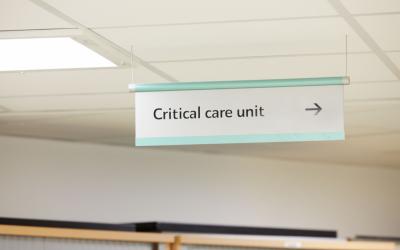Why global health security matters

From infectious disease threats to antimicrobial resistance, many global risks to human health are waiting in the wings. Global health security is an international approach to anticipate and prevent harm to people from these threats, whenever and wherever they occur. Sarah Harrop takes a closer look.
What is global health security?
“In today’s globalized society, a disease threat anywhere is a disease threat everywhere” says the US Centers for Disease Control and Prevention (CDC).
There is no greater reminder of this than the COVID-19 pandemic which rapidly swept around the world after emerging in China’s Wuhan province in late 2019. It became the worst global health crisis in recent history, killing more than 5 million people, pushing an estimated 150 million into extreme poverty, and leaving around a billion undernourished, according to UK Foreign and Commonwealth Development Office figures.
From pandemic threats like COVID-19 to air pollution and food-borne health hazards, global risks to public health are ever-present.
Global public health security is essentially what needs to be done to minimise these dangers and limit their impact on human health, across international boundaries and geographic regions.
It requires strong and resilient public health systems that can prevent, detect and respond to infectious diseases threats, wherever they crop up.
What are some of the biggest challenges to global health security we currently face?
The US Centers for Disease Control and Prevention ranks these among the top global health security risks to human health:
- Emergence and spread of new infectious diseases
Population growth, the spread of urban areas and environmental degradation are bringing wild animals – and the microbes living in and on them – into closer contact with people. New zoonotic diseases (i.e. diseases which can jump between species, like COVID-19, which is thought to have originated in bats), are emerging at unprecedented rates. Some other prominent examples from recent times include:
- HIV/AIDS, which emerged in the late 1970s and is thought to have transferred from monkeys to people. In 2022, according to the WHO, an estimated 39 million worldwide were living with HIV, two thirds of which (25.6 million people) were in the WHO African Region.
- Severe Acute Respiratory Syndrome (SARS), which caused an outbreak in 2002 - 2004 and was later discovered to have emerged from horseshoe bats. The virus behind the disease was a coronavirus, SARS-CoV-1, related to the SARS-CoV-2 which was behind the COVID-19 pandemic.
- Avian influenza - this infectious type of ‘flu virus can sometimes jump from birds to humans in rare cases. The four strains that have caused concern in recent years are H5N1 (since 1997), H7N9 (since 2013), H5N6 (since 2014) and H5N8 (since 2016). While they are rarely transmitted between people, there have been some deaths caused by avian influenza around the world.
- Zika virus – infection with this mosquito-borne disease during pregnancy can cause miscarriage or babies to be born with abnormally small heads (microcephaly) and other birth defects. In 2016, the WHO declared Zika-related microcephaly a Public Health Emergency of International Concern (PHEIC). Although Zika cases declined from 2017 onwards, there’s still low level transmission in several countries in the Americas.
- Ebola virus disease – fatal in around 50% of cases, this virus was first discovered in 1976 and postulated to have switched to humans from fruit bats or monkeys. There have been seven Ebola outbreaks, the biggest of which was between 2014 and 2016, starting in Guinea, West Africa, and spreading rapidly to neighbouring Sierra Leone and Liberia. It was declared a PHEIC in August 2014, and ultimately spread to seven other countries, infecting 28, 600 people and killing 11,325.
- Globalization of travel and trade, enabling disease to spread
Billions of passengers travel on aeroplanes each year, increasing the opportunities for fast international spread of these viruses, bacteria and their vectors (the organisms that carry and transmit them between species, such as mosquitoes). People can also move these pathogens’ animal hosts around the world, either by mistake as stowaways on ships, or intentionally (for example, the pet trade). For example, researchers are concerned that an avian influenza outbreak could kill many more people if and when it emerges than it would have done in the past because of modern human travel patterns.
- Rise of drug-resistant, disease-causing pathogens
Antimicrobial resistance (AMR) is a grave problem and is estimated to be directly responsible for 1.27 million deaths around the world in 2019 as well as contributing to nearly 5 million deaths. The mis-use of antimicrobial drugs such as antibiotics in humans and animals are the main cause behind these pathogens evolving to become resistant and able to survive treatment.
AMR is now widespread across all countries and regions, from wealthy communities to low income ones. Most worryingly, AMR could render antibiotics and antivirals – which fundamentally underpin modern medicine – ineffective. That would make everything from surgery to chemotherapy much riskier and some infections much harder to treat, if not impossible. The World Bank estimates that AMR could cost economically too, with an additional US$ 1 trillion additional healthcare costs by 2050, and US$ 1 trillion to US$ 3.4 trillion gross domestic product (GDP) losses per year by 2030.
“Priorities to address AMR in human health include preventing all infections, which may result in inappropriate use of antimicrobials; ensuring universal access to quality diagnosis and appropriate treatment of infections; and strategic information and innovation, for example surveillance of AMR and antimicrobial consumption/use, and research and development for novel vaccines, diagnostics and medicines,” says the World Health Organization.
These are just a few examples of threats to global health security. Also on the global health security radar is the accidental release, theft or illicit use of dangerous pathogens which pose potential national security risks. Furthermore there are broader hazards for health and the environment, such as climate change, which is causing deaths from extreme weather events and poses a risk to food security; and air pollution, which is now responsible for 7 million premature deaths each year. What is more, as the globalization of food production increases, so does the risk of tainted ingredients and risk of foodborne diseases.
What countermeasures can global health security provide to combat these problems?
To combat these threats, health agencies like the CDC work to strengthen their capabilities in:
- Disease surveillance systems to boost pandemic preparedness and quickly catch outbreaks of communicable diseases before they spread
- Laboratory networks to accurately diagnose diseases and identify new emerging infectious diseases
- Workforce development of outbreak response frontline staff to identify, track, and contain outbreaks at their source
- Emergency management systems to coordinate emergency response efforts when crises occur.
The role of the Global Health Security Agenda (GHSA)
The Global Health Security Agenda (GHSA) is a global effort to strengthen the world’s ability to prevent, detect, and respond to infectious disease threats. It was launched in 2014 and is a partnership between more than 70 countries, regions, international organisations and over 100 private sector companies, non-governmental organisations, and academic institutions. It engages a range of sectors in its work, including human and animal health, agriculture, security, defence, law enforcement, development assistance, foreign affairs, research, and finance. GHSA members share best practices, ensure that global health security is a priority for national leaders and adhere to relevant international standards and regulations’.One notable example is the WHO International Health Regulations (IHR) - a set of rules first adopted by the World Health Assembly in 1969 which call for international collaboration on preventing and protecting against the international spread of disease while avoiding interference with international traffic and trade.
In 2018, all member countries committed to GHSA 2024, the target of which was for countries to take greater ownership of global health security efforts, and for more than 100 countries to improve their health-security-related technical areas within five years. By 2020, 56 countries had met the target, and 20 countries were close to reaching it.
Some of GHSA’s successes to date include:
Improvement of laboratory systems: 18 countries now have the capability to carry out lab tests to detect the pathogens most likely to cause disease, outbreaks or death. If accurate diagnoses can be made, health workers can act faster to treat, prevent and reduce the spread of diseases.
Better surveillance: Event and indicator-based surveillance systems at central and intermediate levels are now available in 18 countries, allowing countries to rapidly detect and stop outbreaks and constantly stay on top of possible risks.
Bigger, better workforces: 19 countries have created or boosted their programme to train disease detection experts, allowing faster investigation of potential outbreaks and swift action to stop them.
Emergency response centres: Public Health Emergency Operations Centres have been established in 19 countries, most of whom are CDC-trained. These centres bring together experts and stakeholders to coordinate the response to an emergency or public health threat.
Gain critical insights to solve tomorrow’s global health problems
Keen to pursue a career that plays a part in tackling the next pandemic emergency response or global health challenge? The 100% online, fully flexible MSc Global Health at Queen Margaret University will equip you with a firm footing in the theoretical and professional analysis of the most important issues in global health and development. You’ll gain insights into how health and development are inextricably linked, why health and wellbeing depends on social determinants, and the importance of both evidence-based strategies coupled with grounding interventions in local realities. You’ll engage in critical and reflexive debate on the pros and cons of development, public health, equity, quality and health outcomes for individuals and communities, which is central to understanding the goals of the UN SDGs and international health.
The Global Health Master’s programme has been carefully designed to fit around the busy schedules of working professionals, so you can earn while you learn and immediately apply what you learn to your professional context.
















The information below is required for social login
Login to your Account